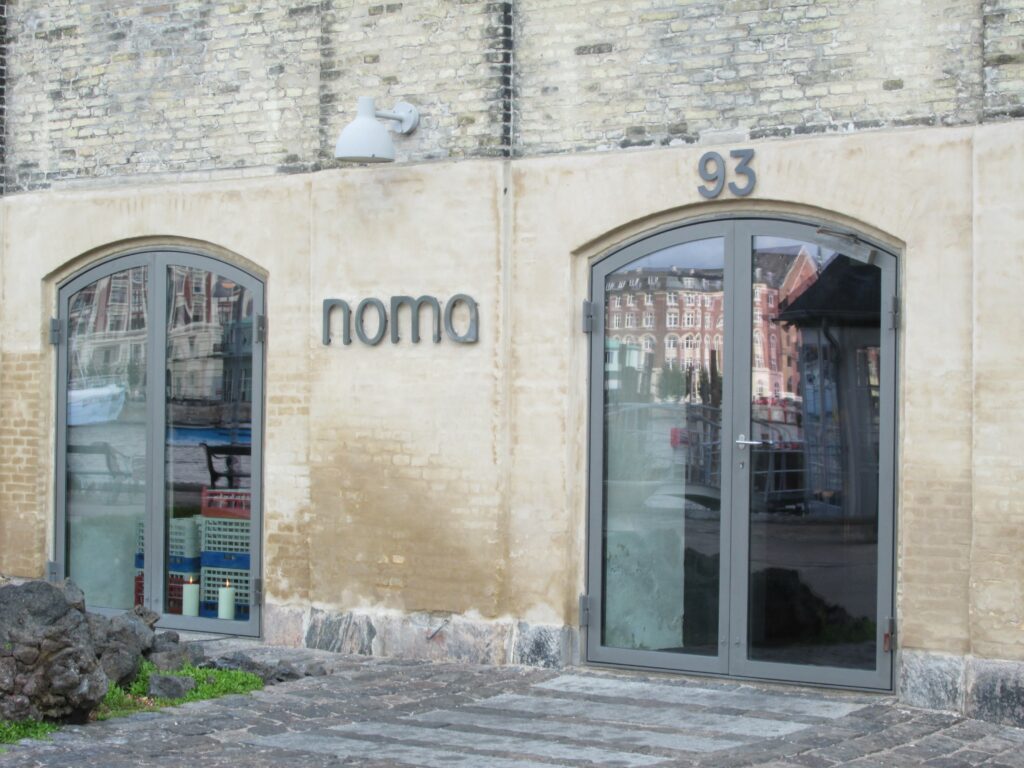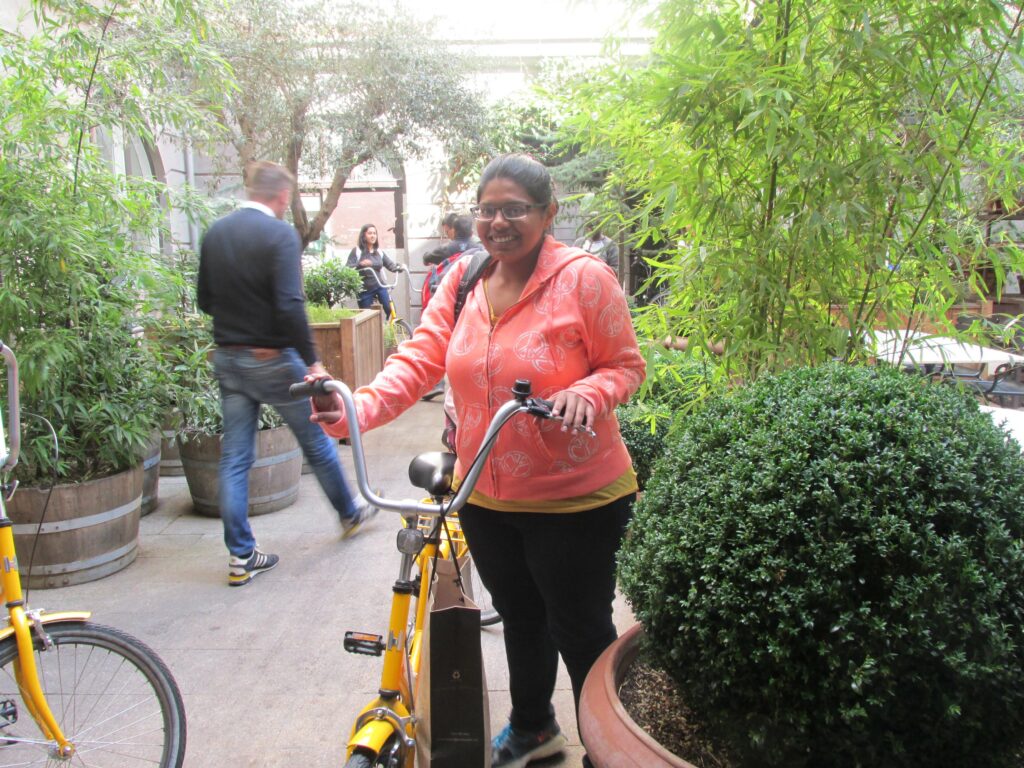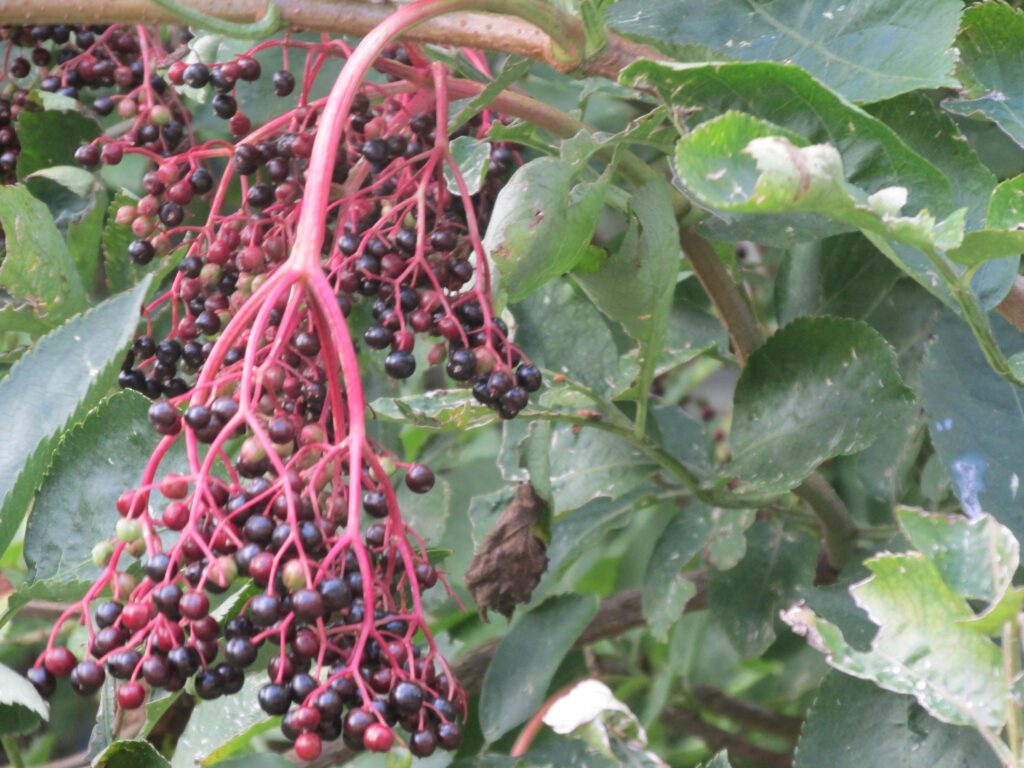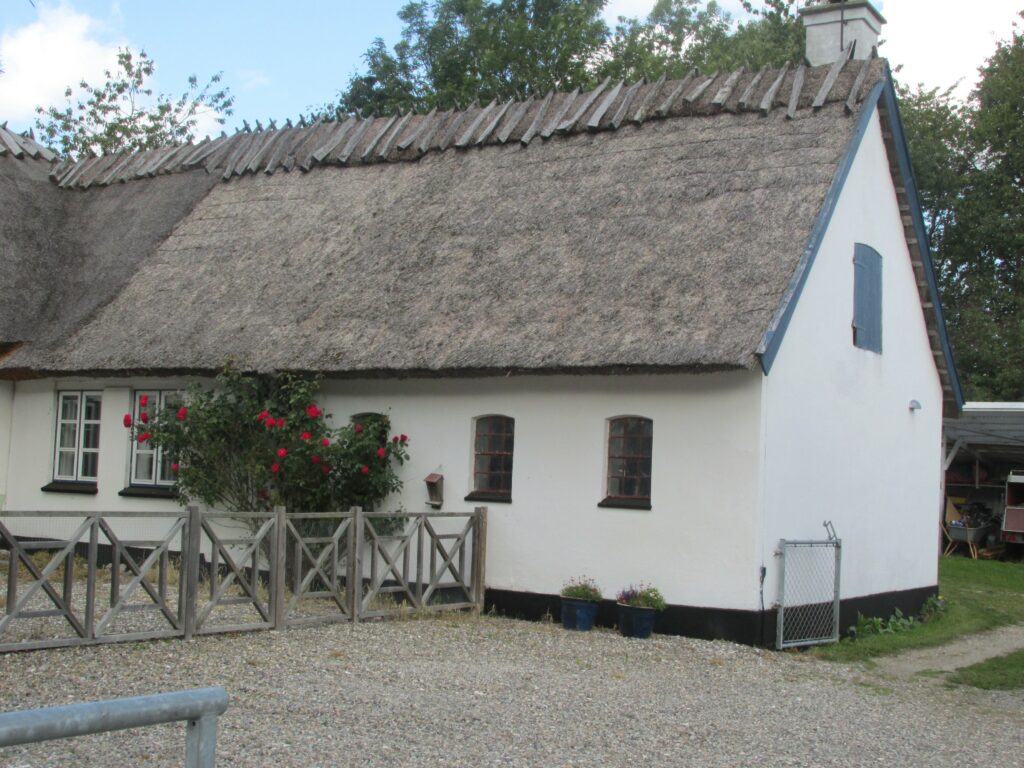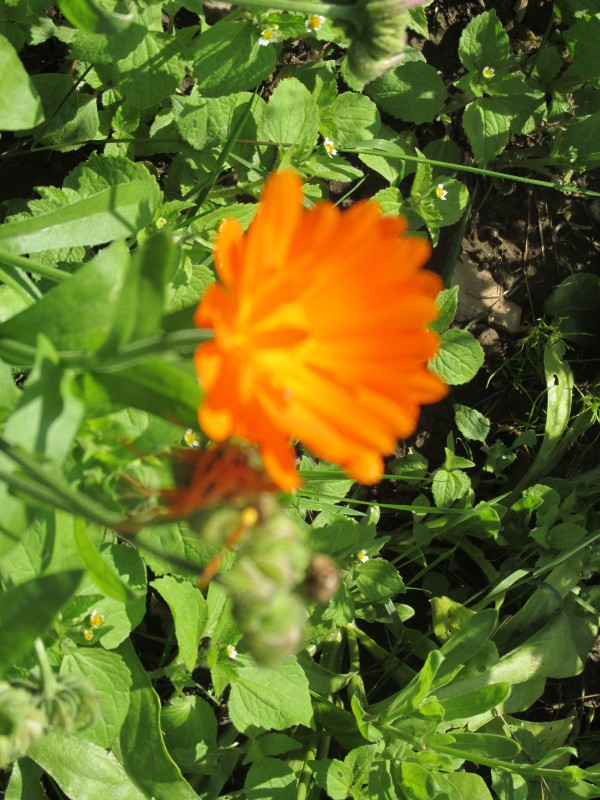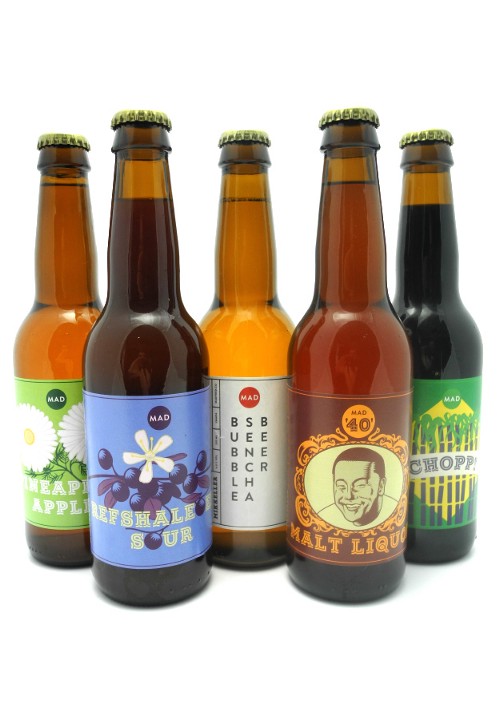This is my journal of a dream week in Copenhagen as a MAD4 grantee.
Thank you Chef René Redzepi, Chef Alex Atala, Chef David Chang, Peter Kreiner, Ali Altinsoy, Mark Hermansen, Gabe Ulla, Arielle Johnson, Leonardo Pereira, Paula Petkova and everyone else whom I met along the way and who made me think a little more about what is cooking?
At the Airport
Wednesday, 20th August (0202 hours)
I never pictured this day. Never dreamed of it. Never even gave it a thought It is something that cannot be expressed through mere words. But now as I’m sitting here at Bangalore airport waiting to board a flight (two actually) to Copenhagen, the picture is slowly starting to form in my mind.
I am going to MAD4! Pretty surreal isn’t it?
Touchdown Copenhagen!
Wednesday, 20th August (1500 hours)
As I walk out of the airport, I see it! That green stoplight sign with three of the most beautiful letters in the Danish language that shout out across borders.

Now it hits me! Here I am! It’s the most wonderful feeling. I am excited to try out new things, understand new ways of thinking, meeting new people, sharing ideas, talking about culture and eating new food!
Driving to the city everything seems so perfect. Perfect houses, perfect roads, perfect people dressed perfectly, perfect rules, perfect bicycling… perfect everything. It’s so amazing to see when one has lived amidst chaos.

I’m excited. A little worried about the bicycling, I might be wobbly and I definitely don’t want to disrupt the perfectness of it all.
We met Paula this evening! She’s the most wonderful person. And so very organized. She’s been coordinating with us MAD Grantees. Paula is so much fun to be with—always watching over us like we’re her kids. Thanks, P!

I’m excited for tomorrow, we get to go to NOMA and meet Chef René. Nothing gets better than this.
I was at Noma today!
Thursday, 21 August
Paula met us for breakfast and we head to Atelier Septemberfor a delicious start to the day.

While we were waiting for our table our day just got bigger! We all were excited about the day at Noma and suddenly out of nowhere chef René greets us in the street. He said he’ll catch us later back at the restaurant. And in a daze we headed off to breakfast.
It was the first time all the MAD Grant participants were meeting together. It was indeed a pretty diverse community table!
Kenya, USA(New Orleans), China, Singapore, Canada, Mexico, Egypt, India; all 10 of us from different parts of the world, we could have had our own little UN! It was exciting to listen to banter in different accents. It’s always engaging to hear someone talk so passionately about their culture.
We began with a bowl of Sencha tea (some of us had coffee) which was followed by fresh grapefruit and the most delicious yogurt. We had buttery croissants and finished with thinly sliced rye with avocados with a lemon dressing.

Aromatic Sencha Tea, juiciest grapefruits and the creamiest yogurt 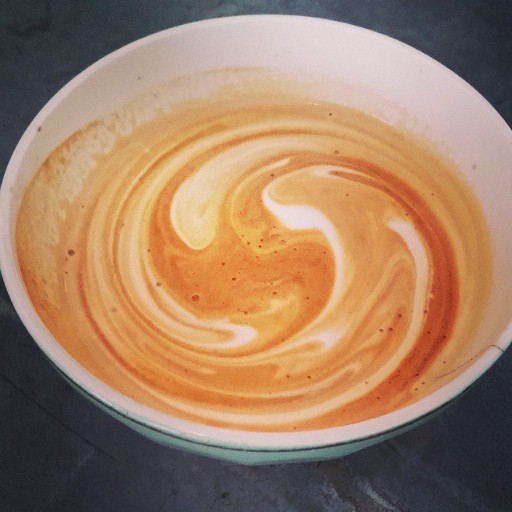
Delicious coffee to begin the day 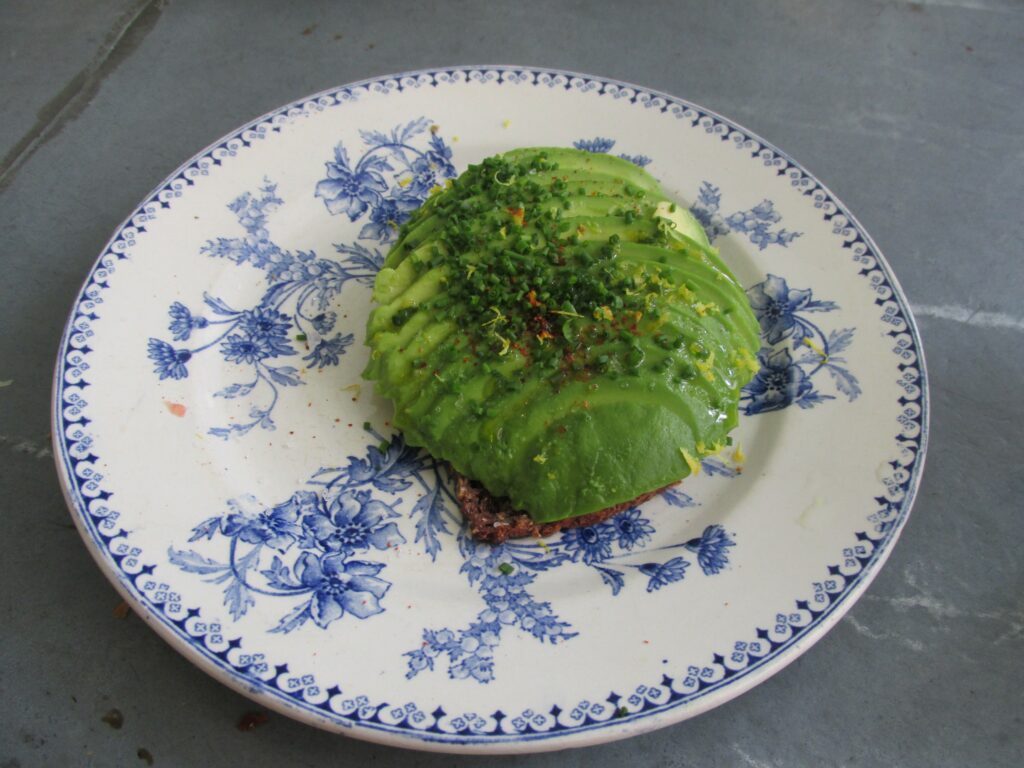
It’s Official: RYE BREAD is the best bread ever!
We walked a little further and got our bicycles and cycled down to NOMA.
We were here. The centre of culinary greatness. It was truly amazing. Walking through the restaurant and kitchens; breathing the same dynamic air.

The service meeting was brilliant to watch. There is so much energy and dedication that you now know why Noma is Noma.
Foraging is a big part of what Noma is about.
We headed to meet Leonardo who was to show and tell us more about this ancient art form. On the way out, we bumped into Chef David Chang. (We were at Noma after all!)
Leo drove us out of the city to Gribskov (Grib forest). Let the foraging begin! The crunching of twigs and rustling of leaves sounded as exciting as firecrackers.
We first found some Wood Sorrel. This heart-shaped leaf has a sharp burst of flavour.
Our next stop was a little bit of a drive away to a farm to pick out some very pretty tasting flowers!
What an afternoon. And the evening only got better!
It’s quite unusual for a laboratory of any sorts to be on a boat. But at the Nordic FoodLab things are as unusual as it gets!

Josh Evans, Captain of the ship, lead researcher and insect extraordinaire took us through the importance of knowing your food, tinctures and polarities, umami, vinegars, lactic acid bacteria and a whole lot of koji.
Maggots and cheese, elderberry vinegar, grasshopper umami, mushroom umami, quince vinegar were some of the weirdly exquisite flavours we got to taste!
We ended the day with some pizza at the family meal at Noma. ☺
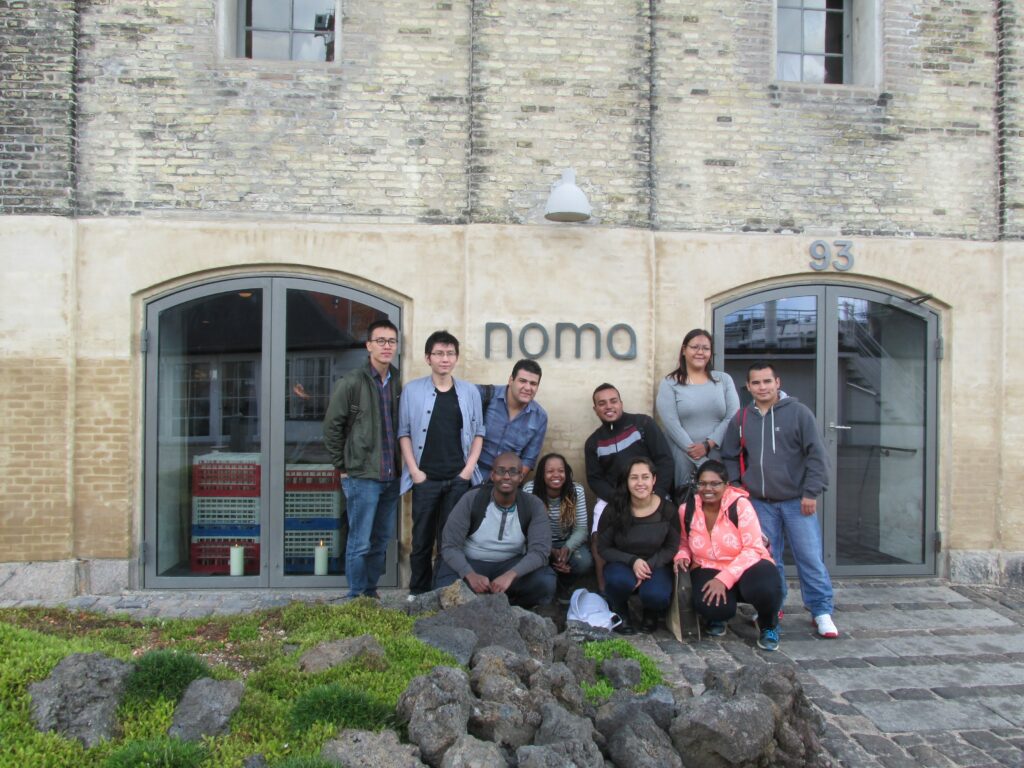
Carlsberg
Friday, 22 August
The Carlsberg Foundation funded part of our grant to MAD4 and we were invited for lunch.
Hannah Parker led us on a fun bike ride to the old Carlsberg brewery. Hannah is a fundraiser at the Museum of Modern Art (MoMA), she’s from North Carolina, she makes her own cheese and she’s helluva lotta fun.

We met with Mr. Peter Moe Rasmussen who is on the board of the Foundation. He showed us around the home of the great J. C. Jacobson, founder of Carslberg, who was not just an incredible scientist but also a patron of the arts! The home is now used for buisiness meets and conferences and is adorned with paintings, sculptures and artwork from around the world.
Lunch was a royal affair. We dined at the Empress Hall in the presence of the statues of Christian IX’s two empress daughters. Sipping on three varieties of beer, we feasted on Scallops with brown-butter, carrots, carrot puree and apples and also devoured a delicious pork brisket with mash potatoes and horseradish.

Lunch at the Empress Hall 


After lunch, we were taken back in time and were told stories of the brew-master and his son, Carl who built the great empire.

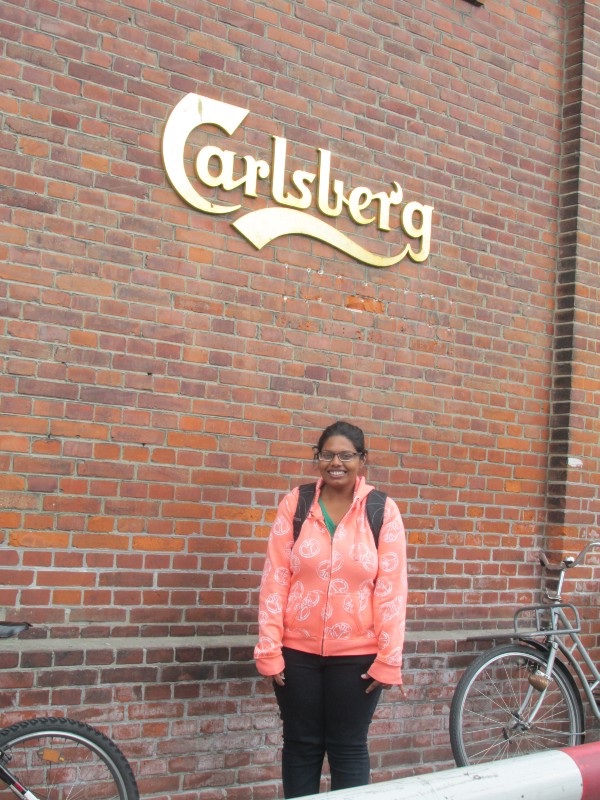





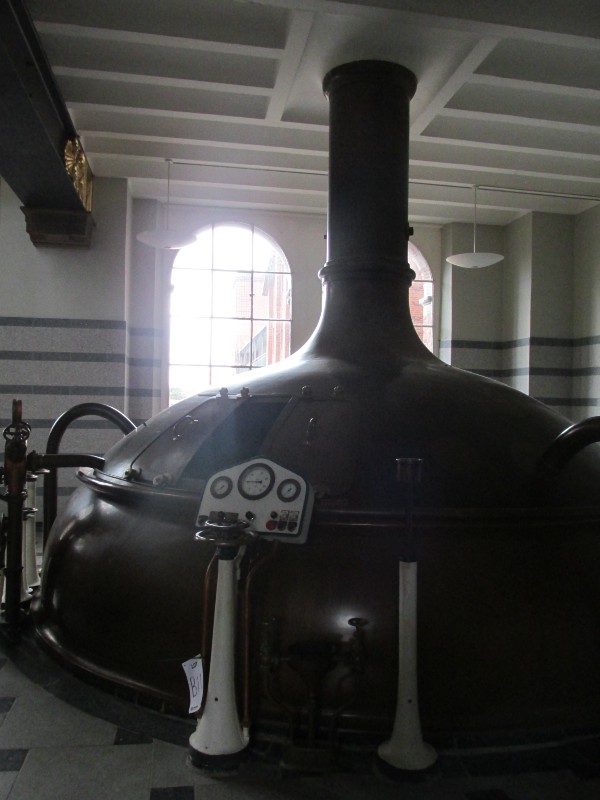



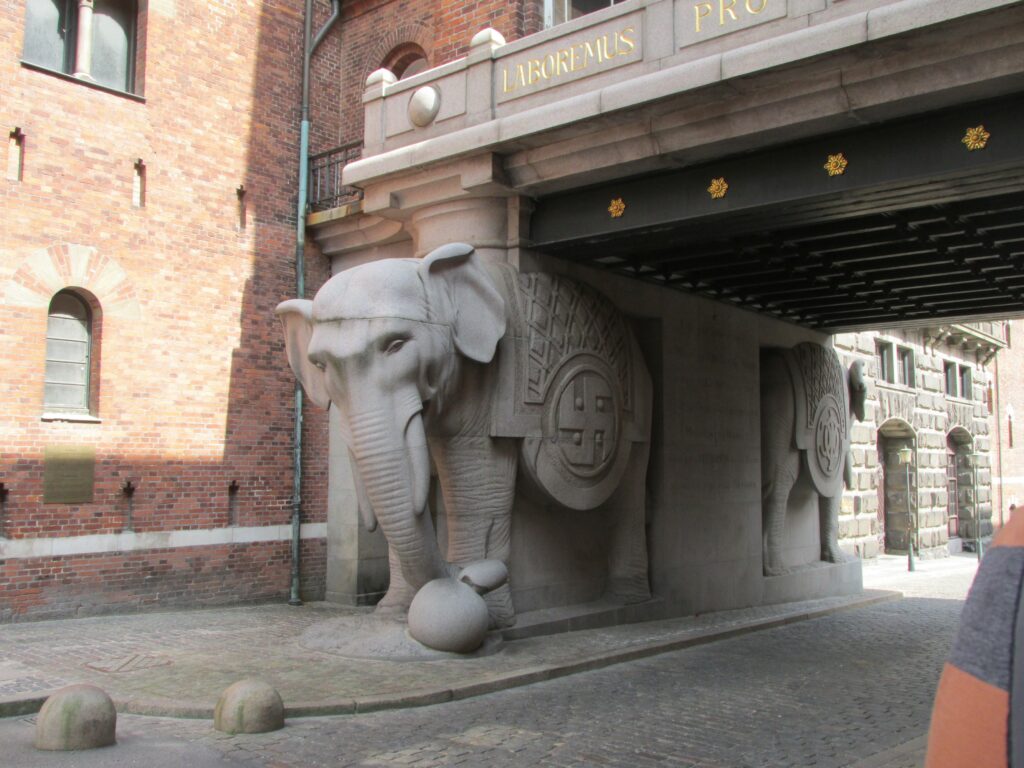
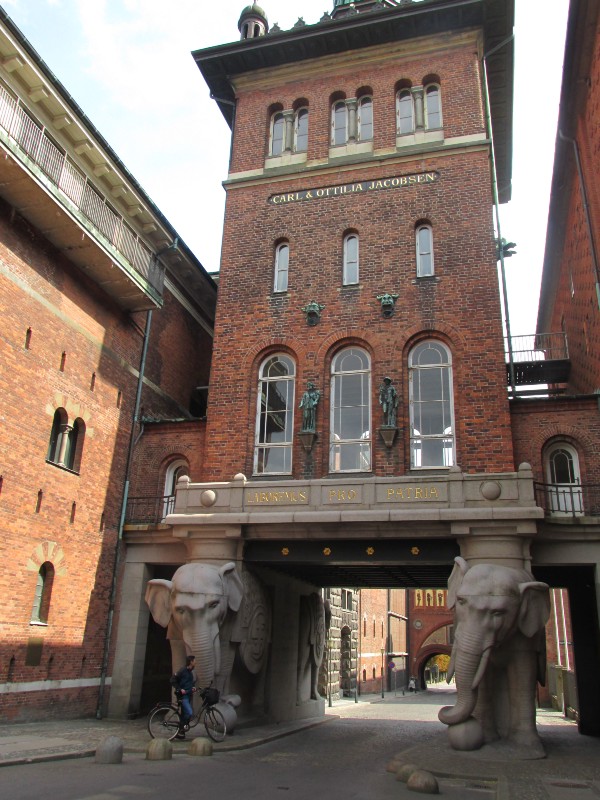

Some snapshots from Carlsberg; The elephants holding up the company; Mr. & Ms. Jacobson watching over the city of Copenhagen; the old brewery; the brewery horses that used to cart beer during the world war.
Further to an exciting day learning about one of the largest breweries in the world, we were very excited about our dinner at Amass Restaurant.

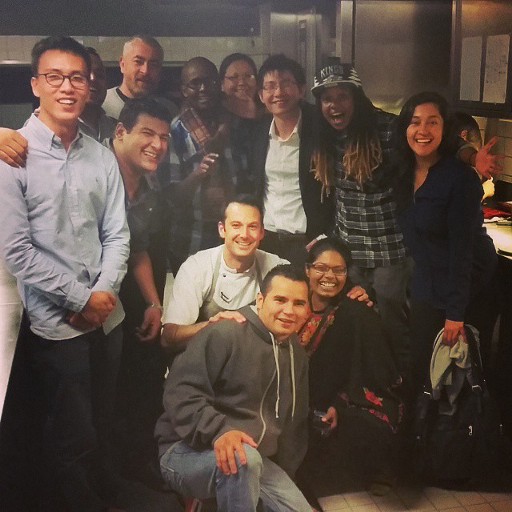












MAD4 Day 1: Let the MADness begin!
Sunday, 24 August 2014
Chef René and Chef Alex were there at the entrance to greet EVERY guest!
The day started with a delicious danish breakfast
Frøsnapper, Rye Bread, Peaches and Apples, Cheese, and lots and lots of brilliant coffee.
- The symposium began in the most apt way. The whole tent watched in silence as Chef Tatsuru Rai, Soba Master and chef-owner of Rakuichi, gently brought together buckwheat flour and water into a dough. He then carefully rolled it out and artfully converted the dough into cooked soba noodles. His movements were so precise and skilled that it screamed out “this is what cooking is”.

2. Chef Alex Atala (co-curator of MAD4) along with Chef René Redzepi welcomed everyone and emphasized the need for a discourse on what is cooking due to the rapid rate at which food is changing. Chef Alex said that luxury, quality and comfort are three important factors that pertain to our food and that an important reason we cook is so that we can make someone happy.
3. Julian Baggini UK-based writer and philosopher stressed on “What we bring to the table when we eat — the moral forces of conviviality”. Baggini began with Soylent and how there are drastic differences between Eating vs. Feeding and Eating vs. Dining there by creating differences in Cooking vs. Preparing. “Animals feed and humans eat” he said, emphasizing on the fact that to us eating is more than just a utility or function. To understand better we saw a picture of the peasant wedding by Pieter Bruegel the Elder, driving home the concept of conviviality.
Julian Baggini also touched on M. F. K. FISHER’sEating Alone. He spoke on how conviviality with food reaches out into the Earth, Animals, Farmers, Producers, Cultures, Ancestors, Staff and most importantly the Cook.
He ended with “How we cook tells us how we live with others in a world we share”
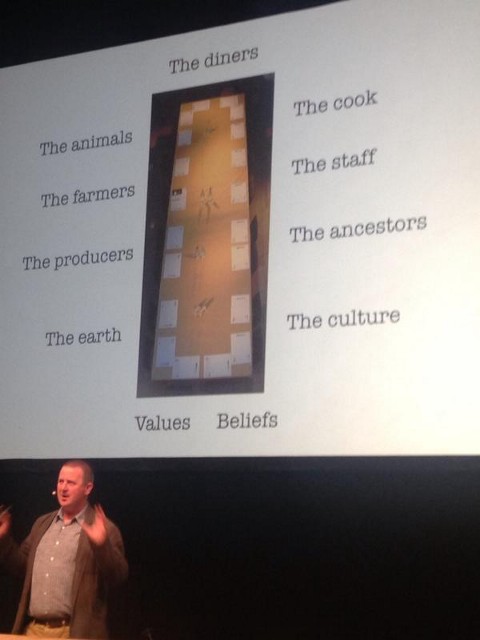

4. Paul Freedman, Professor of History at Yale University, took us from prehistoric to contemporary celebrity chefs, from Apicius to Escoffier to modern day chefs— Chefs who have altered the way we think and perceive food. Marcus Gavius Apicius was believed to be the first gourmand and cookbook writer, who swallowed up his income in lavish hospitality.
Freedman spoke of the extensiveness and heartiness of the feasting in the medieval period.
He spoke of Chef Francois Vatel who denied himself sleep for twelve nights to feed six hundred nobles and several thousand additional people for three days. He was so completely devoted to cooking that when he heard that a fish delivery had possibly gone wrong, he took his own life.
The evolution of dining was discussed. The slow decline of French supremacy is evident with the uprising of ingredients as opposed to tradition

Jehan Georges Vibert — The Marvelous Sauce, 1890 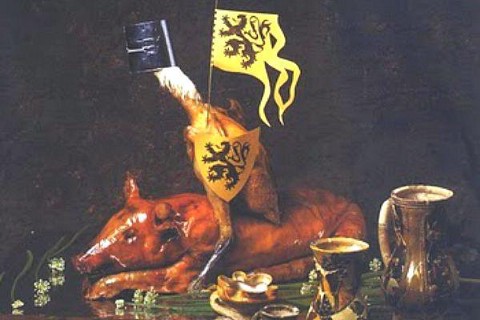
An illustration from ‘Fêtes Gourmandes au Moyen Age’ depicting a gourmet feast in the Middle Ages.
5. Paola Antonelli, senior curator of architecture and design at the Museum of Modern Art started off with a designers aspect on how to fuel the body — the Burton Nitta algaculture project. It proposes a future where humans will be enhanced with algae living inside new bodily organs, allowing us to be semi-photosynthetic.
Similarly, she also spoke about Arne Hendriks and his The Incredible Shrinking Man project which is researching the implications of downsizing the human species to better fit the earth.


We also saw how designers like chefs are thinking “natural” like Mediated Matter at MIT, who designed the Silk Pavilion which was woven by 6,500 silk worms. Maurizio Montalti’s Continuous Bodies The Mycelium Shroud Consists of a hand-made felt shroud inoculated with fungal mycelia. The shroud collects and neutralizes toxic elements stored within the organism and distributes the different nutrient supply harvested from the body, to surrounding life forms. Christina Agapakis’s Selfmade is an exhibit that features cheese made from human bacteria. Each cheese is crafted from starter cultures sampled from the skin of a different person. Formafantasmaexplores design in folk craft, the relationship between tradition and local culture and critical approaches to sustainability.
She also spoke of her new book “design bites” which features gastronomical architecture and talks about a set of designed cultures that generate food that can’t be touched by designers.

The Mycelium Shroud 
Silk Pavilion; 
Formafantasma;
6. As I heard Madhur Jaffery talk about Indian cuisine and it’s medicinal qualities I could picture my mother, grandmother and almost every other elder maternal figure giving me advice about what particular food to eat or spice mixture to boil to get rid of an ailment. She spoke about how we put lots of turmeric in food, not because we love the colour yellow, but because of turmerics endless antiseptic and healing properties. She also emphasized on how culture is like a mother; however much we move away or experiment with new things and places she is always in our minds and hearts.
7. Chef Pierre Koffmann’s under a minute cooking demos were very interesting. An omelet was the first, with lots and lots of butter. He explained that a pinch of salt is the difference between good and bad food.

8. Silvano Giraldin the “front of the house” legend at Le Gavroche talked passionately about the art of service. He spoke of how the new generation of service staff are now just seen as plate carriers. He spoke of how service is an important part of the dining experience and thinks its great that chefs are now serving their own food. “You can take a photo of good food”, he says, “but can you take a picture of good service?”
9. LUNCH! Chefs Rodrigo Oliveira, Thiago Castanho, and David Hertz of Gastromotiva dished out some amazing food.
During lunch we were split into our MAD homework teams for a discourse. I was in Josh Evans’ team and our essay was on Note by Note cuisine created by Hervé This. It was wonderful to hear what everyone thought about where cooking is going and why.
10. Michelin star Chef Alain Senderens, spoke of cooking being about five senses. And that to achieve particular flavours in a dish every chef should understand aromas and profiles of ingredients. Chef Alain Senderens was the chef at Lucas Carton from 1985 until 2005, when he took over the restaurant and turned it into Senderens. He then handed back his michelin stars after the restaurant was relaunched.
11. Chef Olivier Roellinger took his story of cooking back to the history of the spice merchants in Brittany. He explains how his childhood memories of spices from South-East Asia, India, Srilanka, Middle East influenced his style of cooking. The flavours of the spices creates a transition from generic and traditional to more of a dynamic taste. He also spoke about buying eco-friendly produce and fighting against food waste while supporting fair trade and understanding and protecting the diversity of cuisine and culture.
12. Italian chef Fulvio Pierangelini’s talk was in the form of a reply to a letter from Chef René . He spoke about integrity of ingredients,the sanctity of cooking and how each humble ingredient should be given importance. He also gave advice on not being arrogant, being open to learning and staying natural with food (he finds the use of tweezers in cooking or shaping food ridiculous). Although his restaurant Gambero Rosso is now closed, its not the media attention, restaurant team or power he misses. Instead he misses the foraging for ingredients, the burns from the stove, rush from a busy night, the feel of the market and being “hopelessly tired”.
13. Tatiana Levha talked about her journey in setting up her four month old restaurant Le Servan, with her sister Katia, which she termed to be “pleasurable pain”. After training with Chef Pascal Barbot and Chef Alain Passard, she spoke of how it is a completely different story to owning restaurant from working in one. Staff turnovers, menu changes, excessive press were some of the scary things.
14. Anya Von Bremzen spoke on how she understood food being closely related to violence as a child as growing up in the former USSR. There after reading about the copious amounts of food in the “americas” she was then drawn to the romanticism of food and cooking through literature. Bananas being her most vivid childhood food smell.
As a food writer she spoke about the restaurant experience from a diners perspective. She urged chefs to create a culinary fantasy that over powers reality. She also described the thrill of being fed by Chef Massimo Bottura, when he gave her spoonfuls of different food to taste from his kitchen. She also threw an idea out there for everyone to think about. She asked the chefs in the audience to consider having a small bench outside their restaurants where young cooks could buy tickets to come taste the food.
It was an exciting end to day one with a lot of information and things to think about.
MAD4: Day 2
Everyone was so charged to be back for day 2! There was so much suspense as the speaker list was all hush hush.
15. Isabella Suarez started off the day with the inspiring story of her fight against food waste. Fruta Feia, “ugly fruit”, buys fruit and vegetables from farmers whose appearance doesn not meet European Union standards and sells them to customers who do not judge the quality by appearance and wish to be apart of the fight against food waste movement. She has so far saved 42 tonnes of fruits and vegetables from going waste.
16. Gardening Gangster Ron Finley was everyone’s favourite Madtalk. He spoke fervently of his “criminal” journey planting gardens in South Central LA. He changed the law when he was accused of being a criminal while planting a sunflower patch, when the law authorities said it was okay for mattresses to be strewn in public areas. Finley said that he believes growing a healthy community starts with growing good food and encouraged everyone to go back home and “plant some shit”.
17. Rorian Gracie Brazilian jiu-jitsu practitioner and founder of the Ultimate Fighting Championship spoke about his book Gracie Diet, which is based on the eating regiment developed by his uncle Carlos Gracie. He shocked the audience by telling them that for a healthy diet one should eat only three meals a day and never mix together lime and fish. Anything sweet should be eaten as a meal on its own, never after, before or during a meal and every meal should consist of only one kind of starch. To a culinary eccentric audience it must have been hard to digest.
18. Katia Barbosa & Renato Meirelles madtalk was a complete contradiction to Gracie’s. Barbosa, a chef of an eatery in Rio’s Praca da Bandeira neighbourhood and Meirelles, co-author of A Country Called Favella, talked about the food and lives of nearly 12 million people who live in Brazils slums. In the favellas being chubby is considered to be a sign of being healthy. They also briefly spoke of Gastromotiva and how food can change lives.
19. Norwegian Chef Eyvind Hellstrøm, who’s restaurant Bagatelle was the first to be awarded two Michelin stars in Scandanavia. Chef Eyvind spoke of his career which began with Chef Alain Senderens in Paris. He also expressed that food can only be great looking when it is cooked with the right attitude and style.
LUNCH was an epic meal of tacos, burritos, radish kimchi and quesadillas by Chef Roi Choi.
20. Darina Allen, Rachael Allen and Rory O’Connell spoke about the past, present and future of Ireland’s Ballymaloe Cookery School. They spoke of excitement that comes when breaking open a freshly baked loaf of bread and how that skill and passing it on is what cooking is.
21. Chef Pierre Koffman was back on stage and before you could say “artichoke” he had already prepped one and was walking back offstage.
22. Lopes da Silva who is an ecologist, works with many indigenous communities in Brazil. He spoke of the vastness of cuisine. Chef Andre Mifano, who’s Italian influenced restaurant utilizes biodynamic and organic Brazilian ingredients, spoke of a no waste revolution. He emphasized on using good energy from start to finish. He believes this revolutionizes cooking. Good energy helps to reconnect and inspire.
Both also spoke in praise of Chef Alex Atala and his dedicated involvement with the community.
23. David Hertz, chef and founder of Gastromotiva and Jayme Santos Junior, Head Judge of the court of Criminal Enforcement and Comptroller of Prisons in Sao Paulo, Brazil, have together worked to uplift communities through gastronomy. They believe cooking is social rehab. One of their projects is to teach women in prisons how to cook.
Tatu Rönkkö and Efterklang’s performance was sublime!
24. The pioneer of New American cuisine and the first modern day celebrity chef Jeremiah Tower started by speaking of how he refused to cook bad green beans at a food trial. He further explained the importance of benchmarks in the quality of ingredients. Chef Jeremiah Tower also spoke of food trends and his disbelief in them. Simplicity, “something for everyone” concept and making it all about ingredients is his mantra for success. He told the story of his grilled dessert that lanched “California” cuisine and his career. He ended with some words Elizabeth Taylor once said to him, “When the going gets rough, put on lipstick, pour a cocktail, and get on with it.”
25. Chris Ying, editor in chief of Lucky Peach announced his project ZeroFoodPrint which aims to help regenerate the environment through chefs and diners by studying emissions of restaurants and finding new avenues wherein they can reduce their carbon foot(food)print. Noma and Prime Meats (New York) by Frank Falcinelli and Frank Castronovo have reduced 30% of their emissions and now no longer contribute to climate change.
26. Be careful what you wish for, Chef Chris Cosentino warned the audience as he talked of his misled television career and the impact it had on his life. He spoke of how the show instead of being blind tastings had been more of an eating competition of incredible amounts of food and spice. It then left him, as he showed us in pictures, with third degree alkaline burns on the inside of his stomach. He became very sick, unable to even eat tomato sauce at his own restaurant. An opportunity which he had seen that might have been able to contribute more to his family and restaurant ended up doing the opposite. Towards the end he again emphasized on how being a “celebrity chef” may seem glamorous, but in reality it isn’t.
27. There was no better way to end an amazing two days, than with the most amazing chef Albert Adrià. BE AFRAID is what he told the audience. And he went on to tell his journey after elBulli and the fears he had with starting every new restaurant (41 Degrees, Pakta, Bodega 1900 , Tickets, Nino Viejo , Hoja Santa and the upcoming Enigma). He believes that his acceptance of fear as a creativity engine has brought him so far.
I connected with Chef Adria’s “Be Afraid”, because I was and still am; except now I know that it’s part of growing as a cook. I was afraid to send the grant application and afraid to come to Copenhagen, but now I know, being afraid only helps you learn newer, better things and, like MAD, gives you the best experiences in life.
28. Chef René concluded the symposium by going over what MAD is really all about. Now that the four years have been educational he says that MAD5 will be all about putting things into action.

We are MAD 

The under-the-bridge after party by Atelier September was a great end to an amazing weekend.
Last Day in Copenhagen
Tuesday, 26 August 2014
We spent part of the last day in Copenhagen back at Noma and at the science bunker with research manager Arielle Johnson, picking her brains about fermentation and new science projects at Noma/MAD


Pea-so and variants of the Miso, all fermenting at the science bunker!
I then decided to do something touristy and went on the most fun and informative walking tour. Rikke, our guide took us through the entire history of Copenhagen in three short hours.

To end the day and a beautiful experience we had a goodbye dinner at 20a with our “grant” mother Paula and were super surprised and touched when the entire MAD team came to say goodbye too.

Thank you MAD! 
Goodbye Copenhagen
Wednesday, 27 August (0726hours)
Back at the airport. Feels like only yesterday our MAD journey had just begun. As I sip on some coffee and relish a danish pastry from Lagkagehuset, I savour the taste of Copenhagen, and relive the past six days with every bite.
Until next time. ☺
